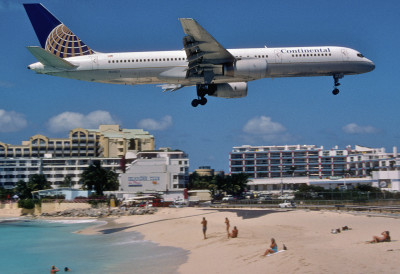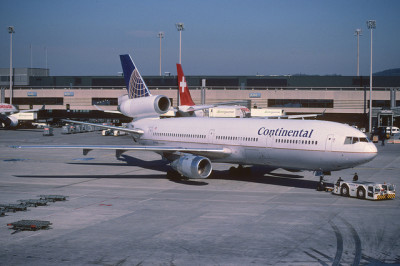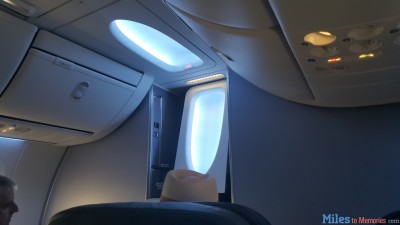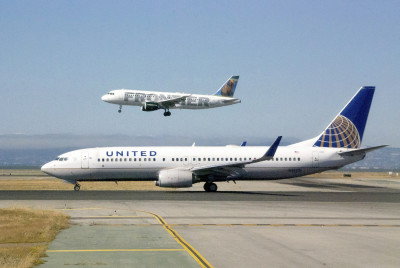Today’s article comes from R.D. Sussman who has previously written fantastic pieces about the modern rise of Delta, the new American Airlines and the History of Low Cost Carriers. He has been involved with the airline industry for over 20 years and is an active travel consultant and airline analyst. R.D. is also a huge #Avgeek and theme park enthusiast.
Before I settle into this, I want to let the audience know: I’m a Global Service on United, inherited from my Diamond Lifetime status at Continental. I flew over 1,000,000 miles on CO from 2003-2009, commuting from the east coast to the west coast twice a month or more over that duration of time.
When I first flew with CO back in 1988, they were still under the thrasing that was the Lorenzo Era – sub par service, unidentified branding & a morass of mess that was their network. At the same time, United was rapidly becoming the gold-standard for airlines, with a reputation for quality, service & performance unmatched by others – a network that saw them gain a foothold in the Pacific, and a future that was getting brighter by the month. CO, of course, would go through another six years of tumultous living before finding the leader they deserved in Gordon Bethune. United continued to grow, to form the Star Alliance & form deep partnerships with foreign carriers strengthening their network further, and maintaining their levels of quality service.

By 2001, things had turned around at Continental. Bethune’s leadership & strategic operations had turned them around, and made them profitable, strong & powerful in any market they enter. Passengers flocked back to CO, as they showed that quality & service meant the world. Of course, 2001 also brought the most dramatic change in our airline industry, one that would change the tables permanently – and also lead to an unholy union in the end.
By 2003, United was failing fast: Poor service, massive job cuts, a product that was lagging behind many other carriers and an aging fleet were dragging hard on their bottom line, eventually leading to bankruptcy. Meanwhile – Continental continued to survive, even the darkest days, while growing successfully and maintaining their reputation for quality, service & on-time performance. And this showed: Of the major airlines in the USA in 2001, only Continental & Southwest survived the decade without a bankruptcy filing, and both were able to turn profits throughout the decade.
CO’s fortunes were excellent – passenger yield per mile was the highest in the industry, and their high-end customers kept the airline’s coffers full. While UA fell, CO was rising – and making money while doing so. However, storm clouds were rising, and in the tide of Delta’s buyout of Northwest, Continental began to look for new alternatives.

Enter Smisek. Jeff Smisek was third in line at CO under Bethune, and took the helm as then-president Larry Kellner retired. And the changes started almost immediately. Meals which were free to all passengers disappeared, the last major airline to do so. Luggage which was free soon came with a fee. And the quality service that CO was known for began to disappear as fast as it could, all in the name of money. Over at United, they were still floundering after emerging from bankruptcy, and demoralized staff were dragging the carrier down. Of course, Smisek thought, what a great time for a buyout!
In 2010, Continental announced the ‘merger’ of United and Continental (though it was in fact Continenal’s buyout of United) and that the surviving carrier would be called United, though using the CO colors & logos. Over the next 18 months, Smisek pushed the two airlines into one – and the trouble began.
The United Experience

Last spring, I had the opportunity to take a flight on the combined carrier for the first time since relocating to the west coast. My trip was via the Chicago base outbound, the Houston base returning – and I can say that everything you’ve heard about United is true, and in many cases worse. Being Global Service with United is a good benefit – when you can use it – but as of late it has become difficult to see what parts of this service are available and which are not. In many ways, this is a huge problem for the best frequent flyers.
Starting at check-in, surly supervisors & staff greeted me as I checked in, and through an embarrassing few minutes, I was berated for (gasp) using CASH to check a bag in! How dare I! Fortunately, a sympathetic employee DID get me taken care of, but the mold was cast: Boarding was a nightmare, with tiered boarding groups so badly crammed together that I couldn’t find either a place to sit, or the right place to board from; indeed, when handicapped boarding took place, I had to figure my way through gate lice to get TO the entryway for the plane.

On board, I can say the crews were among the best I’ve seen at either United or Continental. Friendly, attentive & polite, they were definitely a good spot on the trip. However, the lack of catering onboard meant no food for sale in economy, and basic snacks in First – on a 4 hour flight to Chicago. Fortunately, a 2 minute stopover in the terminal provided me with some basic food for my flight.
Let’s forward to ORD: I’m handicapped, and require a chair for gate changes in larger hubs. To my chagrin, none was waiting for me, and with a 48 minute connection time at ORD, I didn’t have time to wait for it. I did make my connection, but with precious few minutes to spare. Fortunately, the flight was short to my final destination.
Returning to Phoenix, the crews were again great, and showed that they cared. The ground crews at Houston (the largest hub in the United system) were among the surliest I’ve ever dealt with at an airline. A three hour layover meant I had time to spend at the United Club at E terminal, where I found little in the way of food offerings, and instead opted to find food in the terminal. Unfortunately, getting a motor ride to the food court was nearly impossible, combined with (again) as surly gate agent, meant I walked it – with loaded pack.
What Went Wrong?

Needless to say, this was a bad showing on United’s part. And it isn’t the only horror story about the current state of affairs at United; pages on Facebook & all over the web note the poor operational performance at United. Customer service issues have pushed UA up to the top of the DOT complaints list, sharing the space with Spirit, Frontier & Allegiant. This, from a carrier trying to become a global carrier with par to Delta or even American.
So what went so horribly wrong at United? There are so many possible answers here that it could fill a whole column. For me, it is Smisek’s pennypinching in terms of the customer product offerings domestically, as well as the merger of two unlike carriers with different corporate cultures. But in the end, it now comes down to the recently ousted Jeff Smisek, who was terminated last week on 9/8/15. While he made the bottom line shine, and profits soar, he did so at the cost of the passenger as well as to that of the staff at the combined airline. United’s product offering is not much better than that of a ULCC, and while JetBlue, Southwest & Delta are all investing big bucks in improving the passenger experience, United’s lacks greatly in comparison. United has come untied.
Moving Forward

The new CEO, Oscar Munoz, has his hands full starting on day 1. Labor unrest combined with falling passenger counts are just one part of what must be done to turn around the carrier. Customer service must be improved, and not just the lip service given to complaints. Both the hard & soft products now offered domestically & internationally lag behind American & Delta, and are in dire need of improvement. Staff members who have been through this merger need healthy retraining on the focus being the customer – and not just their dollars – which fuels the airline and the growth therein. And management needs to be more adept at negotiating the twists & turns that are the current operational environment. They need to remember the staff are the face of the airline, and not just automatons to the public.
United may be making money – but unlike their competition, they are holding themselves back. It is time to bring United’s product into the 21st century, and to bring back the spirit that fueled Continental to greatness during an era of mass failure.




United bought the contolling interest in Continental in very common merger fashion. Poor fact checking + bias = alternate facts (aka disservice to your readers)
[…] the modern rise of Delta, the new American Airlines, the History of Low Cost Carriers, United Airlines, the History of Air Shuttles, The Middle East 3, Alaska’s purchase of Virgin […]
A little correction here.
UAL Corp. was technically the acquiring entity in the transaction…Continental shareholders will receive 1.05 shares of United common stock for each Continental common share…that mean’s UAL shareholders got 55% of the equity of the combined company. Your statement of CAL acquiring UA is historical revision.
Second, you need to realize that UAL Corp. had been in late-stage negotiations with the Kellner regime in 2008 for a tie-up – before Kellner personally pulled back at the 11th hour. UAL’s board in Chicago was felt lambasted and insulted. That’s something very important to remember, because up until then Tilton and the board had their eyes set only on CAL. After, they vowed to seriously explore “other options”.
The result was UAL Corp. nearly reaching a late-stage merger framework with US Airways in 2010. What happened, as has been publicly reported, and what you failed entirely to note is that Mr. Smisek called Chicago after reading in the WSJ that a UA/US tie-up was literally days away. Smisek knew the continued survival of CAL in light of Dl/NW and UA/US was highly questionable, with a further Ch. 11 all but guaranteed as they got squeezed (UAL had intended to force CAL out of *A in a UA/US deal).
Tilton had CAL right where he wanted them, and this time, he had far more leverage. Not sure if it’s public knowledge of not, but Kellner had gotten significant concessions out of UAL in 2008 – namely the company wasn’t going to be named United, and wasn’t going to be based in Chicago…Tilton used his newfound leverage to directly demand both of those issues to be reversed. The only reason you had the CAL livery is due to Smisek’s knowledge that the CAL board was not going to be pleased about having to concede these two huge points just 20 months later.
Lots of revision I see in your post. I am hardly a fan of legacy UAL Corp. and could go on all day about their sins, but I feel it’s important to note this all clearly.
So I found a copy of the UNITED STATES SECURITIES & EXCHANGE COMMISSION FORM 8-K from March 28, 2013. Page 2, section 2.01 states “Completion of Acquisition or Disposition of Assets: Effective March 31, 2013, pursuant to the merger agreement, United merged with & into Continental, with Continental continuing as the surviving corporation of the merger & changing its name to United Airlines Inc. In accordance with the merger agreement, at the effective time of the merger, each outstanding share of United common stock immediately prior to the merger was cancelled & retired and no consideration was delivered in exchange therefor. Each outstanding share of Continental common stock immediately prior to the merger remained outstanding & was unaffected by the merger”
There seem to be hundreds of big aircraft flying all over the place with huge letters painted on their fuelages that say “United” and there seem to be none that say “Continental”. Just saying. But it may be pointless to apply standard business practices to airlines. I have read that after 100+ years of commercial aviation, the industry may now be entering net profitability. Anyway, the routing rules often make United miles useful to me.
CO changed their name to United because it was more universally recognized
Arguably more universal recognition for Chevrolet than for Rolls-Royce, too, but if Rolls-Royce engineered a merger between the two companies they probably wouldn’t slap a Chevy bowtie on the grille of a Silver Phantom. Lot more likely to see the Winged Lady on a pick-up.
I know what you’re saying, and I agree with you, but even though this was dressed up publicly as a “merger of equals”, everyone thinks that UA bought CO because the surviving entity is called United. But old, previous United went the way of the Edsel, and simultaneously CO changed their name to United Airlines Inc. But because CO management did such a poor job integrating the two airlines, most people assume it was “previous” UA that was the survivor. Smisek & his cronies were widely thought to be the Messiah at CO, but they couldn’t meld the two vastly different cultures. It’s a shame, really…..
Ugh who cares who bought who already. We are stuck with the mess either way. It is time to put it behind us and focus on the future! If not, we will all find ourselves without a job!
You can always tell when one of the legacy UA employees post. Their bitterness and anger is always spewing nonsense.
1. UAL Corp ceased operating Sept 30, 2010. UCH formed and began business Oct 1.
2. It was a stock swap. United didn’t bring any money to the table to buy Continental.
3. Continental’s two bankruptcies in the 90’s would not have prevented them from filing bankruptcy again.
4. Continental began as Varney Speed Lines in 1937, not as People Express.
5. United post bankruptcy had a good on time record, but a horrible completion rate.
6. United post bankruptcy was profitable in 2007, but again posted losses in 2008.
7. United had 4.5b in cash post bankruptcy but they weren’t doing anything with it. Not investing it in their product or in their employees, and it showed when a person flew on United post bankruptcy and pre-merger. They were holding on to that cash to tempt either US Airways or Continental into a merger.
get your facts right! It was UA who bought CO. UAL Corp purchased CO shares in exchange for UAL shares. Period. CO was bought.
CO didn’t file for BK in the 2000s because they already filed twice before. They also were making less money than UA the year before the merger and trailed in on-time performance.
False. The government disagrees.
You’re correct that CO filed for bankruptcy twice, that’s one of the reasons they changed their name to United, however!
As a former employee who got shipped up to the combined headquarters in Chicago for a year, I can say much of the front line problems in customer service are because they are not empowered to handle service issues. Rigid formats, constant defense in terms of reporting and explainations to middle Management set the tone for interdepartmental bickering that consumes more time and effort on pinning failures to others that is better utilized in core fixes.
Routing airbuses through Houston hub to fit the aircrafts range initially was a fail to an all Boeing hub because of maintenance part availability. This has improved somewhat.
At Continental, and as an employee who experienced the worst to first, the huge changes began when employees were empowered to fix problems. This was the attitude we brought along to the new headquarters, met with a deafening cement thud of a wall. Clear interdepartmental boundaries foiled Continentals well known working together mantra and the new Uniteds seeming love affair of long unproductive meetings.
Returning to Houston in ops, it became clear after nearly 30 years, multiple mergers even more CEO’s, it was time to deploy the emergency slide.
As somebody who truly loved CO and what they stood for under Bethune & Kellner, I feel your pain. The attitude I had experienced countless dozens of times at CO was one of pride in a company, of a product, of a plane, of a people. It showed in everything I experienced flying with them over those years. Getting a personal note from the head of Customer Service when I passed my half-million mile mark down to crews who were beyond helpful at a time of loss in my family made it feel like an airline that cared about themselves – and the people who flew on them. That loyalty to people & to the product brings one of the most sought-after things in the airline industry: Frequent flyer loyalty.
When I saw that Smisek’s big plan was the outsourcing of the staff at outstations, I was disheartened greatly. I loved at check in at DCA or PHX seeing people who recognized me, and who I grew to know over the years. They exuded service and skill, and brought together a want to be part of something larger. I knew when I was boarding a CO flight that I would get a consistent level of service that shamed other carriers – whether in coach, first or BusinessFirst. I knew I was in good hands. The people at CO had a great attitude in almost every single area I could see – and I’m sure as you’ve said behind the scenes as well.
One of the greatest fears I saw when the day of reckoning was announced was that the negative attitudes & methods of UA would seep into the good people of CO. And sadly, this came true in more ways than one. In a lot of ways, this can be blamed on Smisek’s inability to lead correctly, to push forward the right way of doing something that was instilled in the CO workforce, but in the end, Smisek decided to let UA’s mentality ruin the show. And now he’s out of a job as a result; Oscar Munoz has a huge task on his hands of turning around a company that could have been great, but fell to their old, dilapidated ways.
I’m sorry to see the carrier lost somebody who understood what it meant to Work Hard, Fly Right. I certainly did appreciate it – as did the many thousands of Ex-Con Frequent Flyers who jumped ship to fly on other carriers with better service, people & standards. Had the CO mentality taken hold at UA, this column would never have had to be written – and we both would be happier I’m sure.
It’s obvious you’re drunk off the COol-Aid, because you continue to blame the pitfalls of the merger on UA. CO was the worst airline in the world, a glorified overrated regional airline. All of the policies and systems used post merger are your precious CO’s. CO’s arrogance in thinking they had what it took to run a global airline is the reason they are failing and it will take years for anybody to try to reverse the damage that CO and Jeff Smisek caused.
. This terrible airline is a giant CO, right down to the hideous livery, awful SHARES computer, and the arrogant CO employees who talk bad about United when they need to look in the mirror. Spare us the rhetoric, UA customers and employees lost FAR more than your precious Ex-COns.
What facts are you using to say that Continental bought United?? This is absolutely not true. United had billions in unrestricted cash on hand at the time of the merger, not to mention they were the number 1 on time airline amongst the majors. And if continental was such a great airline why did everything the brought to the table ruin the airline? (Res system, website, CEO, etc?) I guess tired of people writing articles that are totally slanted to one side. Continental had a great reputation for sure, but they had just as many flaws as united. Continental did not buy United!!!! Although they did take over in terms of leadership. Or maybe you have info the rest of the world doesn’t.
Thanks Alex for pointing that out. UAL had much more cash than CAL. Less debt and less liabilities forthcoming. CAL most likely did not have the cash to cover aircraft orders. The merger was a stock swap not a buyout. I agree with many of your facts, but that one is not correct. UAL was much more efficient in customer check in and operationally more sound. I am also a big fan of Continental, Gordon Bethune, and their amazing turn around. I hope we can work together and stop being divided by management and bitter employees. We will all be without a job if we can’t work together.
A stock swap is a buy out. CO was bought out by United.
When the rumors started of a merger, both the WSJ & other business sites began relaying information that was broadcast out: United wasn’t shopping necessarily shopping, nor was CO necessarily looking. UA’s positions prior to the buyout/stock swap/changeover/megamess were all as a result of the bankruptcy – and not due to good operations.
It was UA who was seeking out CO – but in a way that most people don’t always see: They were looking for somebody who could effectively take over from the post-bankruptcy UA’s position to keep going forward with a network to compete against DL/NW’s massive structure. The overlapping of hubs was not an issue (though people question that with the relative close proximity of IAD & EWR) and there was very little network overlap both domestically & internationally.
In the end, it was CO in control of the deal – down to who would be running the combined carrier, the paint scheme, and in many cases the policies that were enacted under Smisek’s misleadership. Had Bethune or Kellner been in charge, the combination of both carriers would not have occurred. UA’s position of having cash on hand not withstanding, they were fundamentally a carrier without a rudder, a leader and no real future plans. No goals had been in place following the emergence from Ch 11, and by the shape of things, nothing was ever looked at as a way to grow the carrier, manage the changing of the marketplace, or of the issues dealing with competition from all sides. UA saw that in CO’s deal: While CO may not have been the darling that they once were, growth was steady and well-planned, the airline was consistent in product and offering (well, until Smisek took that to the toilet) and they had a basic plan for going forward.
Is this a balance piece? Not at all – it was intended to point out the existing issues with the combined carrier, and the problems that it currently faces, and how bad the operations have become underneath Smisek’s misleadership. UA’s want of becoming as loved as CO never took place, which I think was one of the keys not produced out of the combining of the carriers.
A little correction here.
UAL Corp. was technically the acquiring entity in the transaction…Continental shareholders will receive 1.05 shares of United common stock for each Continental common share…that mean’s UAL shareholders got 55% of the equity of the combined company. Your statement of CAL acquiring UA is historical revision.
Second, you need to realize that UAL Corp. had been in late-stage negotiations with the Kellner regime in 2008 for a tie-up – before Kellner personally pulled back at the 11th hour. UAL’s board in Chicago was felt lambasted and insulted. That’s something very important to remember, because up until then Tilton and the board had their eyes set only on CAL. After, they vowed to seriously explore “other options”.
The result was UAL Corp. nearly reaching a late-stage merger framework with US Airways in 2010. What happened, as has been publicly reported, and what you failed entirely to note is that Mr. Smisek called Chicago after reading in the WSJ that a UA/US tie-up was literally days away. Smisek knew the continued survival of CAL in light of Dl/NW and UA/US was highly questionable, with a further Ch. 11 all but guaranteed as they got squeezed (UAL had intended to force CAL out of *A in a UA/US deal).
Tilton had CAL right where he wanted them, and this time, he had far more leverage. Not sure if it’s public knowledge of not, but Kellner had gotten significant concessions out of UAL in 2008 – namely the company wasn’t going to be named United, and wasn’t going to be based in Chicago…Tilton used his newfound leverage to directly demand both of those issues to be reversed. The only reason you had the CAL livery is due to Smisek’s knowledge that the CAL board was not going to be pleased about having to concede these two huge points just 20 months later.
I’ve seen an SEC report, publicly available & dated March 2013 that states Continental was the surviving entity & changed its name to United Airlines Inc. this is simple fact. As such the majority of management came from CO; they kept CO livery & most of the CO IT.
Someone shared with me a (publicly available) copy of an SEC report, dated March 2013 that explicitly stipulated, in a stock transaction, that CO was the “surviving entity” & “changed its name to United Airlines Inc”! It follows, since they kept the CO livery, website & app, reservations IT, and the majority of management came from CO. This is the simple truth. The so-called “merger of equals” was for the public & rank-and-file employees to digest
CO was owned by UA. UAL Corp bought the CO stock. UAL Corp simply changed their name to United Continental Holdings. Still the Same United and the survivor. UAL had two subsidiaries they merged together which is what you’re referring to. “Continental” wasn’t even CO, it started as PeopleExpress on April 7,1980 and if you don’t believe me, look at the articles of incorporation.
Seek out a copy of the SEC report from late-March 2013 & you’ll see that CO was the survivor regardless of what you perceive to be true
And why don’t you seek out the same SEC report that states that CO was under the ownership of United. UAL Corp bought CO.
i think one of the things you forgot to mention is that, with the merger, may jobs were lost to outsourcing, though when the merger proposal was submitted to congress, they were insured there would be no such thing. many of the ground workers who have kept their jobs have only done so under the threat of taking a huge reduction in hourly wages to meet the outsourced wages or quitting.
I honestly feel that Smisek’s cheapness should be brought to task here – having experienced some of the outsourcing from the Customer Service perspective. Seeing what Smisek did to the rank & file is an abomination, and one I quite personally loathe. A lot of people at both CO & UA got screwed due to the outsourcing in the name of cutting costs & making the stock rise – but the question remains: Was it worth it to deteriorate the product so badly that it is unrecognizable By having a now inconsistent front-line service image is unacceptable under any operation, let alone a carrier trying to be one of the world’s largest carriers. I can see outsourcing at cities where you have, say, three daily flights – but not at ones with 40-50 daily departures.
You are correct: I should have addressed this further in this OpEd piece, but did not. The omission is my fault entirely.
CO was charging for bags before Smisek; United had the highest PRASM before the merger; United had the best on time before the merger. I know you’re an ex-CO guy, but not acknowledging United’s accomplishments before the merger is a big hole.
As for financial performance under Smisek, bottom line only soared because of gas prices. Compare them against DL (now that’s soaring), and UA did relatively poorly under Smisek.
Of the majors, CO was the last airline to impliment the fees for bags – I should have clarified that a bit.
As for Smisek – personally, he is a disgusting louse that joins Lorenzo, Wolf & Bedford at the boarding gate to hell. What he did to both UA & CO is lamentable under any accords.
Yeah buddy
Besides generating profits for shareholders and exec golden parachutes, the other big factor which has made
‘not caring’ not only possible, but a bottom line generator is the consolidation into 3 giant carriers. The attitude is ‘You want to fly? Then pay the ticket, sit down and shut the $#*! up!’ There’s your customer
service model in two understandable sentences. Just wait for more consolidations to come where we can
foresee the re-branding of the one surviving carrier into Aeroflot’s 1958 business plan. Wall St. will love it!
I keep reading how their international hard and soft product lags American, but on my last two trips to Europe in business class, I have to say both the soft and hard product was better on united than American (us airways planes though, if that is the reason )
Just out of curiosity, what type of bag is a Global Services member required to pay for in order to check?
In this case, I was travelling with an oversized bag (Medical equipment that didn’t fall into the ‘free’ bag category as it required special handling) and had to pay the fee for transport. I did not know at the time of booking that special handling bags are still subject to the fee – and ultimately have contested that with United’s Global Service Desk.
I hope that clarifies things a bit.
R.D.
My thoughts exactly!
The “summer from hell” was 2000 – then came 9/11… it’s essentially been downhill for 15 years and counting